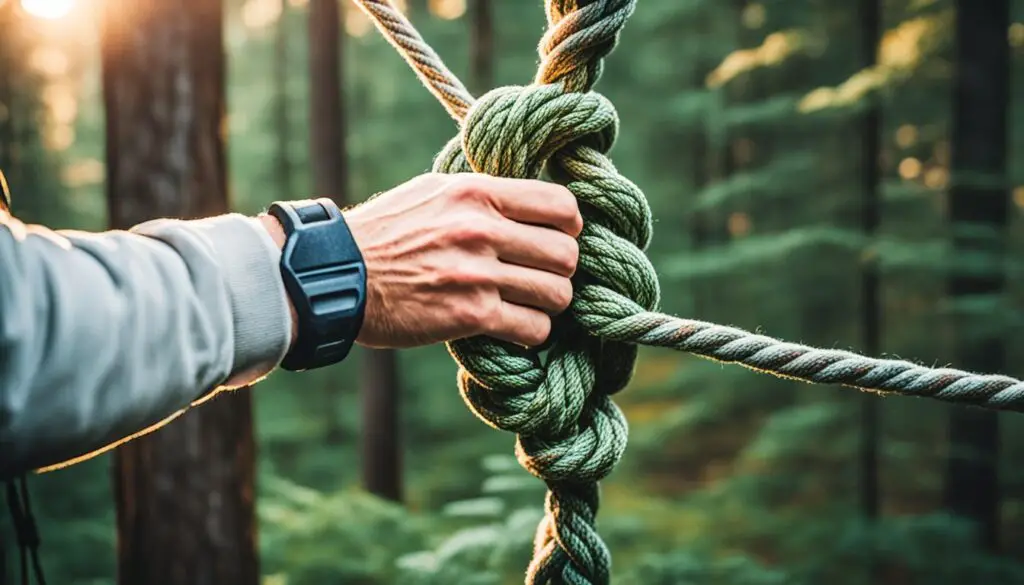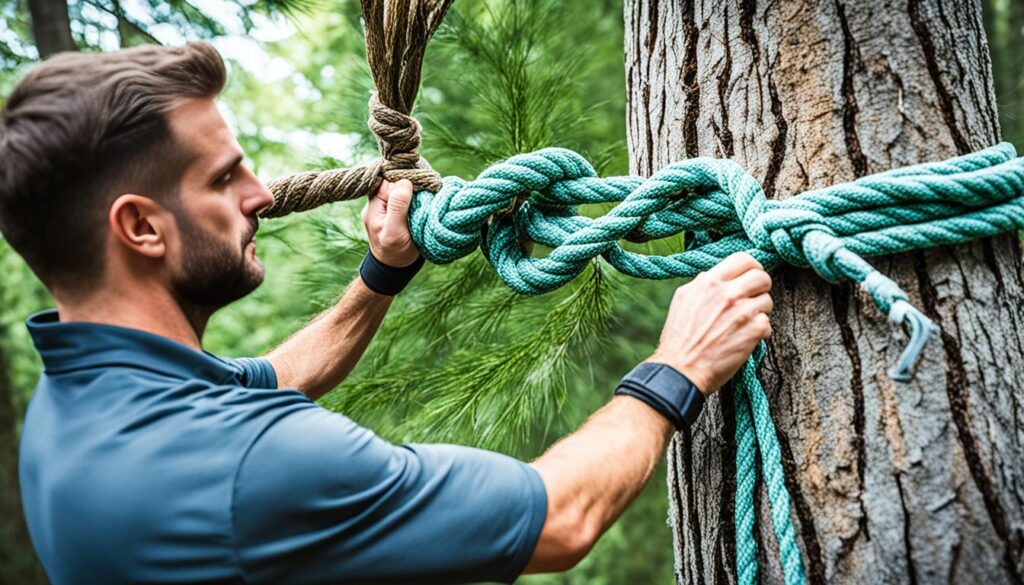How to Tie Camping Knots Step by Step
Being a keen camper, I know mastering knot tying is key. It lets you fix gear, make shelters, and move through nature safely. Follow this guide to learn the top camping knots. It will boost your outdoor trips.
Knowing how to tie knots helps a lot when you go camping. Whether it’s for tents, bear bags, or kayaks, strong knots keep things safe. These skills prepare you for many challenges during your adventures.
I’ll walk you through tying major camping knots. From the Bowline for fixing to the Clove Hitch for various uses. You’ll soon be skilled enough to use these knots everywhere, making your camping times better and more fun.
Introduction to Essential Camping Knots
Are you someone who loves the great outdoors? Learning how to tie knots is key for better camping trips. It helps keep your stuff safe, build shelters, and move through nature easily. Let’s discover why knot tying is so useful for campers. We’ll also look at important knots you should know.
Why Knot Tying is Crucial for Campers
Knot tying matters a lot for campers. It helps you secure your gear so nothing gets lost or damaged. Whether you’re setting up a tent or tying down your canoe, strong knots are a must.
Also, knowing how to tie knots is important for setting up shelters. You might need to make a tarp shelter or tie your tent securely. Using the right knots makes your shelter stable and safe from bad weather.
Learning to tie good knots is also key for wilderness survival. If something goes wrong, you can use knots to make shelters, tools, or ask for help. Knowing the right camping knots could save your life outdoors.
Overview of the Most Useful Camping Knots
There are important knots every camper should know. Some include the Bowline Knot for making loops, and the Two Half Hitches for tying things together. We’ll cover more essential knots for your next camping adventure.
How to Tie Camping Knots Step by Step
Knowing how to tie camping knots is key for outdoor lovers. In this guide, you’ll learn to tie essential knots. With these skills, setting up your camping site, securing gear, and exploring outdoors will become easy.
The Bowline Knot
The bowline knot is very useful in camping. It’s strong, creates a loop, and doesn’t slip easily. To tie a bowline knot, follow these steps:
- Make a small loop in the rope’s end.
- Put the rope’s end through the loop, around the rope’s length, and back through the loop.
- Wet the knot then pull the rope’s end to tighten.
This knot is great for tying things to trees and making loops in a rope. It’s also good for saving people. Because it’s simple and strong, it’s a knot you should know when camping.
The Clove Hitch
The clove hitch is crucial for camping. It’s fast and steady for tying a rope to a tree or elsewhere. To make a clove hitch, do this:
- Wrap the rope’s end around the object two times.
- Put the end under the last wrap and pull it to tighten.
- Wet the knot and adjust to make sure it’s tight.
It’s good for putting up tarps, securing lines, and tying things to your pack. This knot holds onto things well and is great for many camping needs.
The Trucker’s Hitch
The trucker’s hitch makes tightening a rope easier. Here’s how to do it:
- Put the rope’s end through the object you need to secure.
- Bring the end back and through a loop in the rope’s length.
- Wrap the end around the length and back through the loop.
- Wet the knot then pull the end to tighten the hitch.
It’s great for making tarps secure, fastening gear, and setting up tight lines. This knot helps tighten ropes well and is important for camping.
To get good at these knots, you need to practice. With time and effort, you’ll tie them easily. Check out ShopEverBeam, WoodlandWoman, and Wilderness College for more help with knot tying.

| Knot | Description | Applications |
|---|---|---|
| Bowline | Forms a secure loop at the end of a rope | Securing ropes to trees, creating loops, rescue operations |
| Clove Hitch | Attaches a rope to a tree, post, or object | Setting up tarps, securing guy lines, lashing items to packs |
| Trucker’s Hitch | Creates a mechanical advantage for tensioning ropes | Securing tarps, tying down gear, creating taut ridgelines |
Mastering the Bowline Knot
The bowline knot is key for camping, known for its strength and use in sailing. Many love it, from sailors to hikers, for good reason. We’ll show you how to tie it and its many camping uses.
Step-by-Step Guide to Tying the Bowline Knot
Learning the bowline knot is important for every camper. It’s easy to learn with a few tries. Here’s how to tie a bowline knot step-by-step:
- Hold the rope with your dominant hand, the end pointing away.
- Make a loop near the end.
- Loop the end up through the loop, around the rope, and back down.
- Wet the knot and pull it tight.
Practice makes perfect. Soon, you’ll tie a bowline knot quickly and securely.
Applications of the Bowline Knot in Camping
The bowline knot is very useful while camping. Here’s how campers use it:
- Securing Tent Lines: It’s great for holding up tent lines, making your shelter strong against wind and rain.
- Fastening Guy Lines: Use it for tying tarps or awnings tightly, ensuring they stay put.
- Creating Rescue Loops: In a rescue, it makes a safe loop to throw to someone who needs help.
- Attaching Ropes to Carabiners: It’s a favorite with climbers, giving a secure connection.
Knowing how to use the bowline knot well makes camping safer and more enjoyable.
| Bowline Knot Benefits | Bowline Knot Uses in Camping |
|---|---|
|
|
Tying the Clove Hitch Knot with Ease
Learning to tie knots is key for campers. One of the most useful knots is the clove hitch knot. I’ll show you how to do it step by step. This guide is for everyone, whether you’re just starting or have lots of outdoor experience.
The clove hitch knot is great for tying ropes to trees or poles when you camp. It’s fast and easy to adjust. This makes it perfect for many camping tasks like tent set-up, putting up tarps, or hanging your gear.
How to Tie the Clove Hitch Knot
- Hold the rope’s end while leaving a little slack.
- Wrap the rope around the object, like a tree or pole.
- Bring the rope back to create a loop.
- Push the end through the loop.
- Finally, pull the end to tighten the knot. Make sure it’s snug.
The clove hitch knot is both easy and handy. With these step-by-step instructions, you can learn how to tie the clove hitch knot easily. This knot is useful for many camping uses.
Practical Applications of the Clove Hitch Knot
This knot is super useful outside. It’s good for:
- Attaching ropes at campsites for tents, tarps, or shelters
- Helping with the stability of your outdoor structures
- Keeping bags of food high up and safe from animals
- Securing boats or gear for travel
Being able to do the clove hitch knot well is a plus for all campers. With this step-by-step guide and knowing its camping uses, you’ll be a pro at tying knots. This means your camping stays will be safe and solid.
Conclusion
We’re ending our trip through camping knot tying. Hopefully, you now know how important tying knots is. It keeps your camp safe, your stuff secure, and makes camping better.
Learning camping knot tying skills is key for great outdoor times. It brings confidence and helps you handle tough jobs. Plus, it makes you ready for surprises. The outdoor knot tying benefits are many, like setting up camp better and feeling closer to nature.
Keep working on your knot tying techniques. They’re super useful for any outdoor adventures. The better you are, the more you’ll enjoy nature. Don’t forget, importance of knot tying for campers is huge. It’s about safety and fun in the wild.
FAQ
What are the most essential camping knots I should learn?
The most essential camping knots are the Bowline, Clove Hitch, and Taut-line Hitch. Also, the Figure-Eight Knot and Timber Hitch are important. These knots help keep your gear safe, set up shelters, and navigate safely outside.
Why is knot tying an important skill for campers?
Knot tying is vital for campers. It lets you keep your gear safe, make shelters, and move safely in nature. Learning to tie strong knots makes camping better and helps you face outdoor challenges with more self-assurance.
How do I tie the Bowline knot?
To tie a Bowline knot, do this:
1. With your left hand, make a 6-inch loop in the rope.
2. Put the rope’s end up through the loop, around the standing part, and back down.
3. Make the knot wet and pull the end to tighten it.
What are the practical uses of the Clove Hitch knot in camping?
The Clove Hitch knot is handy in camping in many ways. It can tie ropes to trees or poles, secure tarps, and make a safe point for climbing or rappelling quickly.
How can I improve my knot tying skills for camping?
To get better at tying knots for camping, practice often with different ropes. Watch how-to videos, join workshops, and learn from experienced campers. Regular practice and a desire to learn make you good at tying the important camping knots.
